Redness, peeling of the skin on the legs, the appearance of cracks between the fingers, feet ulcers, a change in nail condition: loss of shine, the usual pink tone, plates thickening - these and other signs indicate the development of a fungal infection. Each fifth resident of the earth is sick with ringworm. Therefore, you need to know how the fungus looks and behaves in the legs, it causes it leads to its appearance and how to treat this unpleasant disease.
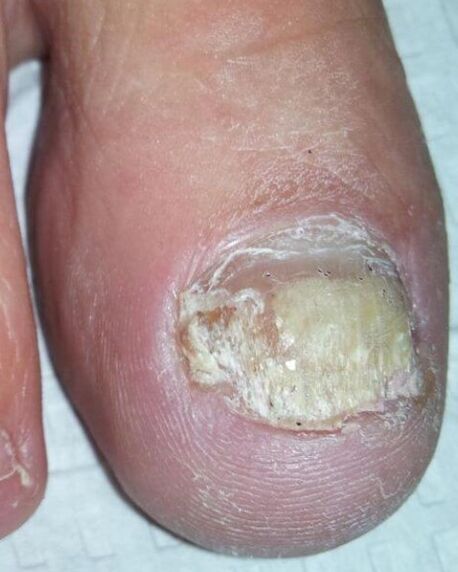
Reasons
In most cases, ringworm infection comes from a person to a person directly or through neighboring objects. The favorable conditions for the reproduction of the fungus are fever, moisture. Disputes can also maintain viability in a dry state, after low quality manicure tool processing.
The main reasons for the disease include:
- Lack of regular feet care.
- Accommodation with a person who suffers from a fungus.
- Using someone else's shoes, socks.
- Stop injury.
- Visiting common areas of "mushrooms" (beaches, baths, pools).
- Insufficient processing of pedicure accessories.
- Wearing tight shoes of synthetic materials.
- Professional harming (work under high temperature and humidity conditions).
- Shoes shot in a store without sock or detachment.
Fungal diseases in humans develop faster against the antecedents of the characteristics of functioning, as well as changes that lead to the suppression of immunity, with impaired local circulation, changes in skin condition. Body reasons are as follows:
- Endocrine pathology (diabetes, obesity);
- pregnancy;
- States of immunodeficiency;
- Increased perspiration;
- foot diseases;
- Vascular disorders;
- Chronic skin diseases (eczema, psoriasis);
- Long -term intake of drugs that suppress immunity (corticosteroids, cytostatics).
Types of pathogenic mushrooms
Mushrooms in the human body feed on protein - keratin, elastin, collagen, dividing them with enzymes: keratinase. The location of ringworm depends on the activity of keratinase and the ability to digest different types of keratin.
Mycoses in the legs cause the following types of fungi:
- Trichophyton rubrum-one type of saphophites fungi that inhabit a layer of keratinized skin. It causes the lichen cut, damage to the epidermis, nails in 80 % of cases.
- Trichophyton Mentagrophytes causes epidermophite stop.
- Trichophyton interdigital. In the legs, the fungus causes dermatophytosis, onychomycosis.
- Candida mushrooms affect skin and nail plates with a severe decrease in immunity, affect skin plates and nails with a serious decrease in immunity.
Fungal skin lesions
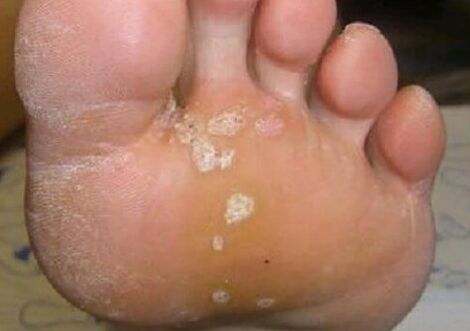
Mycosis in the legs, skin injury during psoriasis (sometimes called dry fungus) - peeling red plates and a fusion tendency rising above the surface. Such elements are often found on the knees, legs. This disease is not associated with a fungal infection.
The manifestations of foot fungus are conditionally divided into four main forms. The convention is in a combination of clinical signs and the possibility of transition from one to another.
In intertiginous form, the skin is suffered in interdigital spaces. The skin fungus of the legs manifests itself in the form of itching, burning, is accompanied by an unpleasant odor. Often the infection affects the foot of the intervals between 3 and 4, 4 and 5 fingers. The skin turns red, soaked in moisture, wounds, crying areas appear between the fingers. These signs develop independently or against the bottom in an existing scam.
Observation! For typical intertiginous injury, the connection of a secondary bacterial infection that exacerbates the disease. Bacterial, mycotic eczema develops with the formation of a rash not only in the foot, as the inflammatory elements appear on the ankle, lowering.
The advanced form of scaly-hiperkrototic looks common and huge corns in the sole with cracks. Initially, the mycosis of the leg skin can attract attention with dryness, peeling the skin from the feet, the harsh corn limited in the heels. People consider these symptoms an individual feature and do not turn to a dermatologist. Skin lesions can accompany the itching, burning. If you look at the fungus photos on the legs with this form of ringworm, you may notice deep cracks against the bottom of a thick (and, as it were, moccasins pants) of the skin of the feet. Such manifestations are painful. The squamous shape is characterized by the involvement of nail plates with their destruction, a delay behind the nail bed.
The manifestations of the Dishydrotic (vesicular) form of the foot fungus are uncommon. The main symptom of the disease is the formation of bubbles with a thick shell and transparent content. They are located on the single side of the foot, their fingers as unique or drainage formations. Then the bubbles are open with the formation of erosion with purulent crusts around the edges. The complications of the vesicular lesion include:
- Toxic-allergic reactions. They develop for 4-6 days, often located symmetrically: swollen reddish papules can be found in the foot, leg, forearm, face, mucous membranes.
- Connection of a bacterial or viral infection secondary to the development of eczema.
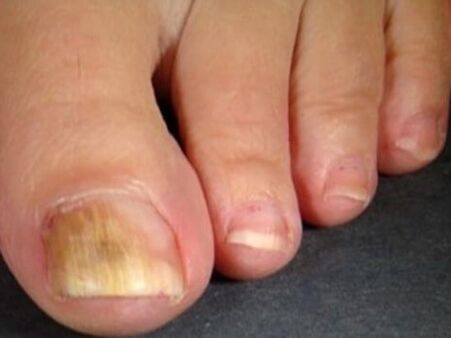
The erased form of the fungus on the feet is characterized by minimal injuries, so it is not easy to recognize it. The main signs: the appearance of intensifying peeling, the formation of microcracks between the fingers, discomfort, burning. With a long course, nail plates are involved.
Nail fungus
Onychomycosis appears as a result of skin fungus in the fingers, feet, lack of attention to the problem and proper treatment.
The first symptoms and signs of onychomycosis may also go unnoticed. You should contact the nail fungus on your legs and contact a dermatologist at:
- change in the color of nail plates;
- the appearance of yellow or gray spots;
- Loss of shine;
- Appearance on the surface of irregularities;
- strips in the nail structure;
- Increased fragility.
There are several classifications of onychomycosis. By the appearance of the nail plate, they are divided into:
- Normotrophic. The fungal infection alters the color of nails to yellowish gray, thickness and shape remain the same.
- Hypertrophic. This type of fungus is characterized by gross changes: nails are yellow, thickened. If you look at the photos that represent this type of onychomycosis, you may notice a shape of the plates. Transversal studies, loosening and free border fragility are visible. This change in nails leads to its growth. Walking becomes painful.
- Onical. Nail plates become thinner, change color, exfoliate from the nail bed.
According to the location and degree of damage to the nail plate, the following types of onicomycosis are distinguished: distal; side; mixed, proximal; total; surface.
Candidiasis defeat
Separately, damage to Candida mushrooms should be considered. These conditionally pathogenic mushrooms cause deep mycoses (affecting internal organs) and surface (dermatomycosis, onychomycosis). Under normal conditions, human immunity suppresses the reproduction of this fungus and a massive infection does not occur. Therefore, Candida's activity manifests with significant disorders in the body of protecting the body and requires a complete exam to establish the cause of immunodeficiency. The first signs of infection are difficult to distinguish from lesion, frostbite.
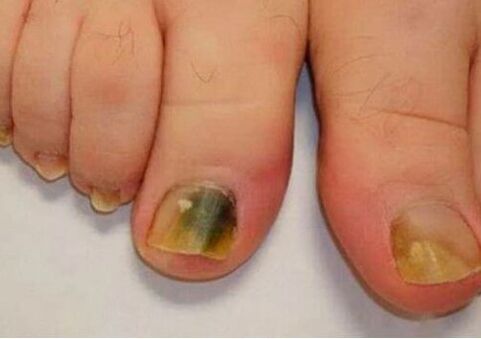
Fungal damage to the legs develop as follows:
- On the fingers of the legs, there is an inflammation of the rolls of nails with redness, swelling, cracks in the skin, the appearance of discomfort in any movements. Under nail plates, a whitish purulent tone is formed.
- Inflammatory changes in the skin decrease, the disease becomes chronic. The skin around the nail thickens, stops growing. The infection affects nail plates.
- The nails on the legs begin to thicken, to sprinkle. Its color is brown, brown. The violation of blood supply leads to rejection.
Diagnosis
The diagnosis of the fungus on the legs includes:
- Conversation with the patient (complaints, diseases that accompany, working conditions, clarification of the possibility of infection).
- Inspection.
- Laboratory research methods (skin scraping, nails with microscopy, sowing from a harvest dedicated to the determination of drug sensitivity, IG G for Aspergille, candidates).
Treatment
The fungus on the legs requires immediate treatment that a dermatologist (or mycologist) will prescribe. You can perform outpatient tasks.
How and how to treat the fungus on the legs depends on several conditions:
- Pathological process location;
- degree, gravity of defeat;
- the presence of concomitant diseases;
- patient's age;
- In cases of women therapy - the fact of pregnancy, breastfeeding.
The treatment of fungus in the legs takes a long time and its main objective is the disappearance of clinical and laboratory signs of infection. An incomplete therapy course leads to the relapse of the disease.
Drug therapy
Drug treatment is performed using antifungal medications that not only destroy ringworm but also help remove inflammation manifestations and eliminate secondary infection.
They are divided into:
- Local. Apply to the lesion (ointment, gel, cream, spray, varnish, solution).
- Systemic - Take orally (tablets, capsules, solutions).
In the early stages of a fungal infection, drug therapy is limited to the appointment of local funds. With common mycosis, with a severe course, systemic antimychotics is required.
Treatment with folk medicine.
There are many recommendations on how to get rid of the fungus on the legs of folk and household medicine. The most implies external use and some - inside. However, you should not drink and apply dubious compositions to your feet in the hope of bringing neglected ringworm. Such folk methods can harm health.
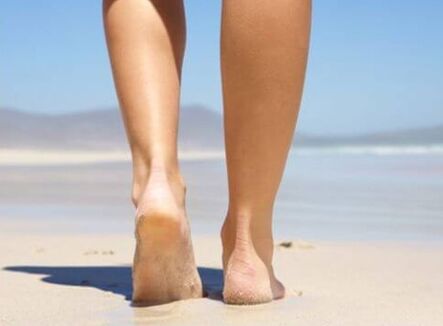
Observation! The most common and effective home remedy for the fungus is the legs for salt, soda and essential oils. These therapeutic procedures prepare feet and nails for the application of medicines.
Surgical treatment
With huge fungal damage, nail plates will have to be removed. This method is safe and practically does not have against -indications. An alternative to surgical manipulation - the use of pastes and ointments to soften the removal nails.
Laser treatment
The use of a laser to combat onychomycosis is based on heating and destruction of fungus spores with a targeted beam. This technique allows you to quickly cure onicomycosis, secure and applicable in patients who are against systemic treatment.
Dermatomycosis Treatment
To start the treatment of the fungus, local antifungal agents are used in the legs. If after a two -week treatment course, there is no improvement in the condition, an antimycotic agent will be required. In case of serious damage, the skin fungus requires the prescription of systemic medicines. Therapy continues until complete elimination of infection.
Treatment of Onychomycosis
To eliminate the initial manifestations of nail fungus, local medicines are prescribed. Mycosis with an injury of more than 2/3 of the nail area, involving growth zone, distribution to other signs - an indication for taking systemic medications. Onychomycosis with massive destruction of nail plates begins to be treated with the surgical removal of the affected tissues of the nail. This method provides access to the focus of the infection.
Important!
Treatment of onychomycosis is performed before the cultivation of healthy nails and can last up to 12 months.
The appearance of the fungus in the legs can be caused for several reasons. A careful attitude towards your health will help to recognize the disease over time and start treatment.



























